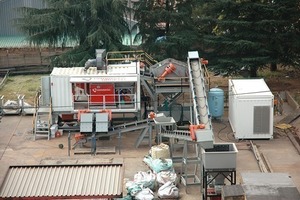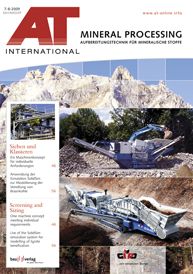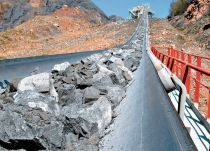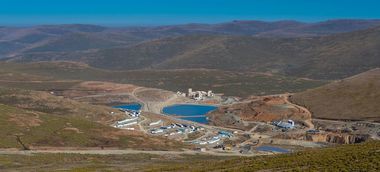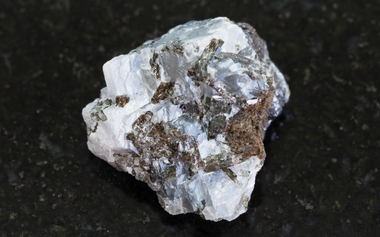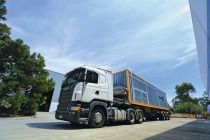Sorters reduce mining costs and increase profits
At a recent mining convention in Las Vegas, Mathias Moritz, MD of Commodas Mining GmbH in Germany, delivered a strong and positive message to delegates: sensor-based sorting machines have impacted on the mining industry to the extent that they are fast replacing the traditional, high cost methods of milling and expensive metallurgical processes. Tough economic times have led to a steady decrease in raw material prices, particularly in the mining industry. Mines using electronic sorters have reported a significant reduction in mining costs and an increase in profits. Once on stream, the benefits are almost immediately reflect-ed in the bottom line.
“The advantages of eliminating waste and sub-economical ore from plant feed are convincing,” commented Professor Wotruba of Aachen University in Germany. He went on to say that traditional pre-concentration methods for plant feed have limited applications, whereas sensor-based sorting can separate material which is impossible to treat by traditional methods. “Sorters can work, where these methods fail,” he said.
1 Mature technology for versatile applications
Using high speed, high tonnage sorting machines has markedly reduced beneficiation costs. The new generation of sorting machines are so sophisticated and versatile that a number of loss-making operations have been able to maintain production by mining and sorting low grade ore bodies, extending the life of the mine and preventing closure. The current financial downturn has forced mines to lower operational expenditure (Opex) and increase output to ensure the survival of the mine.
Commodas sensor-based sorting machines detect and separate the valuable ore fraction from barren residue at high speed (Fig. 1) and at low cost, with close to one hundred percent accuracy. Increasingly, this technology is also being used in other industries, such recycling and dump reclamation.
The effectiveness of advanced process and separation technology is clearly evident at a limestone quarry in Finland, where over 220 000 t of valuable white limestone was extracted from the waste rock dump, thanks to the use of optical sorting technology. This investment in sorting not only paid for itself, but also allowed the limestone plant to once again operate profitably.
According to Rosemary Falcon, Director of the Fossil Fuel Foundation and professor in the School of Chemical and Metallurgical Engineering at the University of the Witwatersrand, Johannesburg, the application of X-ray sorting on dry coal has solved a long-standing problem in the coal industry. “These sorters identify and separate torbanite from coal,” she said. “The typical method is to separate coal from the host rock using heavy media concentration with the torbanite fraction included. Since this is a mineral rich clay with a high proportion of fossil algae, and is a valuable source of high quality coal, bitumen and oil, the X-ray sorter has made an enormous difference in separating torbanite from the lower grade coal.”
2 Investment in the future
Sensor-based sorters represent an investment in the future, with long term advantages over traditional processes that are slow and inefficient, resulting in poor recovery rates. Updated sorting technology ensures that only the valuable mineral fraction is retained for further processing and waste or barren material discarded. Waste is removed on site before milling; pre-concentration can take place on surface or underground; and chemical usage is considerably reduced. Fast processing results in a quick return on investment, consequently, net present value is increased.
With sophisticated detection, process separation and ejection systems, sorters use a number of intelligent detection criteria to identify ore and mineral characteristics, such as colour, atomic density, transparency and conductivity. These include optical and colour recognition, X-ray transmissions, radiometry, near-infrared, fluorescence, conductivity and magnetic systems. This technology is successfully applied to a wide variety of minerals, metals and gemstones.
A focused approach to research and development guarantees ongoing optimisation of systems producing reliable, state-of-the-art machines that are at the forefront of sorting technology. Fast throughput rates, low maintenance costs and a proven global track record attest to the rising demand for sensor-based sorting machines not only in the mining industry, but also in commercial and industrial operations. The recent merger between Commodas and UltraSort, both leaders in the field of sensor-based sorting systems, brings new innovations to mining technology. The two companies create a formidable team with years of accumulated knowledge, experience and specialised skills. With one hundred machines installed worldwide, many operating in the harshest of conditions in remote and almost inaccessible areas, Commodas and UltraSort are now recognised as the world’s leading suppliers of high capacity, sensor-based sorting systems.
With representatives on all major mining continents, they are able to provide fast service reaction to clients. Fully equipped test facilities are located at Commodas in Wedel, Germany; Mintek, in South Africa (Fig. 2); UltraSort Ltd. Pty, Australia and at SGS Lakefield, Canada. In the near future, a test facility will be opening in Russia.
Sensor-based sorters not only increase profit by improving yield and recovery, but reduce emissions and energy consumption, thus they are environmentally friendly.

